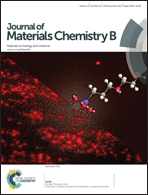The role of ligand–receptor interactions in visual detection of HepG2 cells using a liquid crystal microdroplet-based biosensor
Abstract
Liquid crystal (LC) microdroplets have been prepared for visual detection of HepG2 cells using 4-cyano-4′-pentyl biphenyl molecules in the presence of sodium dodecyl sulfate as a mediator and β-galactose-conjugated poly(styrene-b-acrylic acid) block copolymer (PS-b-PA-G) as a modifier of LC–water interfaces. To clarify the effect of β-galactose-containing ligands on the orientational transitions of LC microdroplets, maltotriose as a ligand simulant was conjugated to poly(styrene-b-acrylic acid) and used as a LC modifier. The interaction of HepG2 cells with the β-galactose-conjugated block copolymer was effective in causing orientational transitions, from radial to bipolar, in LC microdroplets, whereas interactions of HepG2 cells with maltotriose-conjugated block copolymers were ineffective in inducing orientational transitions in LC microdroplets. To confirm the necessity of the PS segment of the block copolymer for transmitting the ligand–receptor interaction forces from the interface to the core of the LC microdroplets, β-galactose-conjugated block copolymers (PS-b-PA-G) and homopolymers (PVLA) were synthesized and used to prepare LC microdroplets. The LC microdroplets containing a β-galactose-conjugated homopolymer did not show orientational transitions upon contact with HepG2 cells. However, LC microdroplets containing a β-galactose-conjugated block copolymer showed orientational transitions from radial to bipolar, indicating that the polystyrene segment in the amphiphilic block copolymer is essential for the effective transmission of ligand–receptor interactions to the core of LC microdroplets. β-Galactose anchored LC microdroplets were able to detect 1.0 ± 0.1 HepG2 cells per μm2 of the test cell and had shown significantly high reproducibility (p < 0.05, n = 3). The configurational transition in LC microdroplets that was dependent on ligand–receptor interactions was used to develop a LC microdroplet-based biosensor for the detection of HepG2 cells in biological fluids.


 Please wait while we load your content...
Please wait while we load your content...